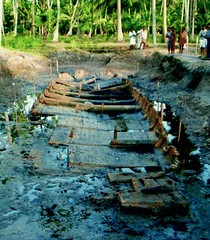The stegodon was a elephant like animal that lived in Asia about 5.3 million to 1.8 million years before present. These animals were about 13 feet high, 26 feet long and had 10 feet long tusks. Stegodons were earlier considered to the ancestor of elephants and mammoths, but now they are considered to be the sister group of the mammoth and the Indian and African elephant. Recently archaeologists from the ASI (where else?) found some tools in Jharkhand’s East Singhbhum which resemble the stegodon.
The deep elephant-shapped furrows stunningly resembled ‘stegodon’, the first of the true elephants that had probably roamed in this part of the world during the ‘pleistocene’ period, the official said. Chauhan said the length of the ‘elongated’ truck is very long and the about four-inch imprint point to a primitive species. “This unusual figure of an elephant on the stone at Basadera takes one back to a primitive period,” he said.
“The technique ‘block-on-anvil’ and ‘block-on-block’ adopted to shape and size the tools found by us and their striking similarity with the tools discovered in the river valley indicate the age of human habitation which could be older than the one discovered near Jamshola by the anthropologists from Kolkata,” he said. The discoveries should be enough pointer to the perception that East Singhbhum might have seen transformation of primitive men, he said. [Vital clues about primitive human beings]
Tags: stegodon archaeology Jharkhand
